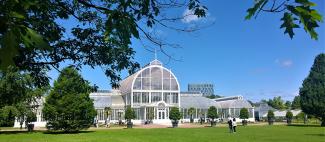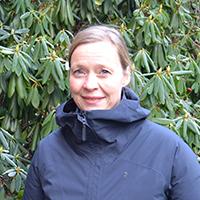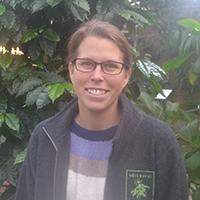Handbook shows how greenery creates sustainable cities
Birds chirping and trees can contribute to sustainable urban development. A project within Mistra Urban Futures has developed a method and handbook that wants to make ecosystem services valued higher in cities.

The densification of Swedish cities has in recent decades led to a decrease of greenery in our cities. Therefore, it was an important and very topical issues researched in the project Valuation of ecosystem services provided by urban greenery. Ecosystem services simply means functions of ecosystems that benefit people, improve our well-being and our living conditions. One example is pollination. In the project, the ecosystem services studied were those that among other things contributes to climate regulation and improved air quality.

- The purpose of the project was to study the connection between urban greenery and ecosystem services. We developed a method that enables identification and an overall assessment of the urban greenery's ecosystem services in order to promote sustainable urban development, says project manager Sofia Thorsson, professor at the Department of Earth Sciences at the University of Gothenburg.
The working method consisted of measurements and inventories in seven areas in Gothenburg, Sweden where ecosystem services from greenery in the city was assessed and valued. The results from the project confirm that green areas supply a number of important ecosystem services to the city's residents and visitors.
The results showed, for example, that the level of air pollution from busy roads drops rapidly the further into a green area one comes. This effect is greater during the summer months when the greenery is fully developed. Measurements also show that vegetation has a noise-reducing effect and that the trees lower the air temperature during both day and night. Trees in sunny places are especially important for cooling. If you reduce the urban vegetation, the air quality, the sound environment and the local climate will thus deteriorate.
- Based on our own and international research, we believe that the urban greenery must be valued higher than it is today. New housing and communications must be combined with the preservation of important ecosystem services. We must become better at integrating greenery more efficiently into urban planning, says Sofia Thorsson.
Emotional values were also valuated in the project. One example is that green areas are widely used by local residents for recreation and they are highly valued, especially if they have a high degree of naturalness, or in other words untouched areas.
- The well-being of local residents who visit the areas is highest among women and the elderly. In addition, nature sounds such as bird song are important, not least in areas with a high perceived naturalness. These areas also had greater biodiversity, for example in the form of trees and songbirds, than areas with low perceived naturalness, says Sofia Thorsson.

As a continuation of the project a handbook (in Swedish) was produced. The purpose of the handbook is to in a pedagogical way describe to urban planners how to assess and value the benefits of greenery in cities. During the process of developing the handbook, the working method was tested in new areas in collaboration with, among others, the City of Gothenburg.
- We are particularly pleased that the method shows how different components within a green area contribute to different ecosystem services and that it is developed to be easy to use, systematic and transparent in all stages. We are also pleased that it includes cultural ecosystem services such as recreation and aesthetic value, says project manager Jenny Klingberg, environmental researcher at the Gothenburg Botanical Garden.
The interest in the handbook and the method has been great. The handbook has been presented in many different contexts, for example at the Swedish Environmental Protection Agency's network meeting for officials, urban planners and others who work with ecosystem services, and in discussions with the Boverket – the Swedish National Board of Housing, Building and Planning, the Swedish Transport Administration, the Gothenburg Region (GR) and the Park and Nature Administration, the City of Gothenburg. The unit manager Ingela Gustafsson at the Parks and Landscape Administration, city of Gothenburg says that they know the method well.
- The handbook can be a good complement to, in particular, the work on compensation measures in the city's planning work, she says.
The handbook is relevant in the work of several of Sweden's environmental goals and the importance of ecosystem services is also mentioned in the government's strategy Strategy for Livable Cities - policy for sustainable urban development (strategi Strategi för Levande Städer - politik för en hållbar stadsutveckling). One of the environmental goals is that by 2020, municipalities should have access to a developed method for utilizing and integrating urban greenery and ecosystem services in urban environments in planning, construction and management of cities and urban areas. Boverket – the Swedish National Board of Housing, Building and Planning refers to the handbook in its document Ecosystem services in the built environment - guidance & method.
- I do not think it is possible to find one method that works in all contexts where ecosystem services in the urban environment are to be valued and assessed, but this method and the handbook is one piece of the puzzle in the work of highlighting the value of greenery in urban environments, says Jenny Klingberg.
One direct impact of the project is that the research is described in the City of Gothenburg’s Plan for Greenery, which contains environmental goals to be reached by 2035. Sofia Thorsson also sees other effects of the research project.
- There is a great need for methods for evaluating ecosystem services of urban greenery. The framework we have developed is intended to be used as a support in the planning process in order to assess the impact of changes in the cityscape, such as densification or to follow changes over time. Our method is intended to meet this need, says the project manager.
Project facts
Project title: Valuation of ecosystem services provided by urban greenery
Project period: 2013-2016
Partners: University of Gothenburg, Chalmers University of Technology, Swedish University of Agricultural sciences, City of Gothenburg., Swedish Transport Administration and Gävle University.
Financier: Swedish Research Council Formas, Swedish Transport Administration and Mistra Urban Futures.